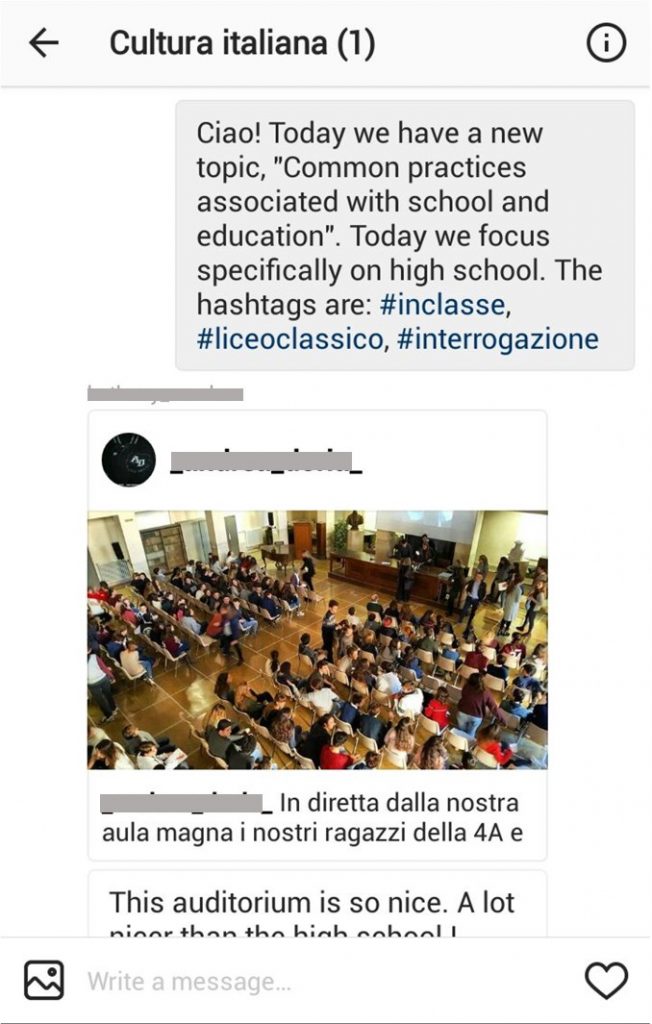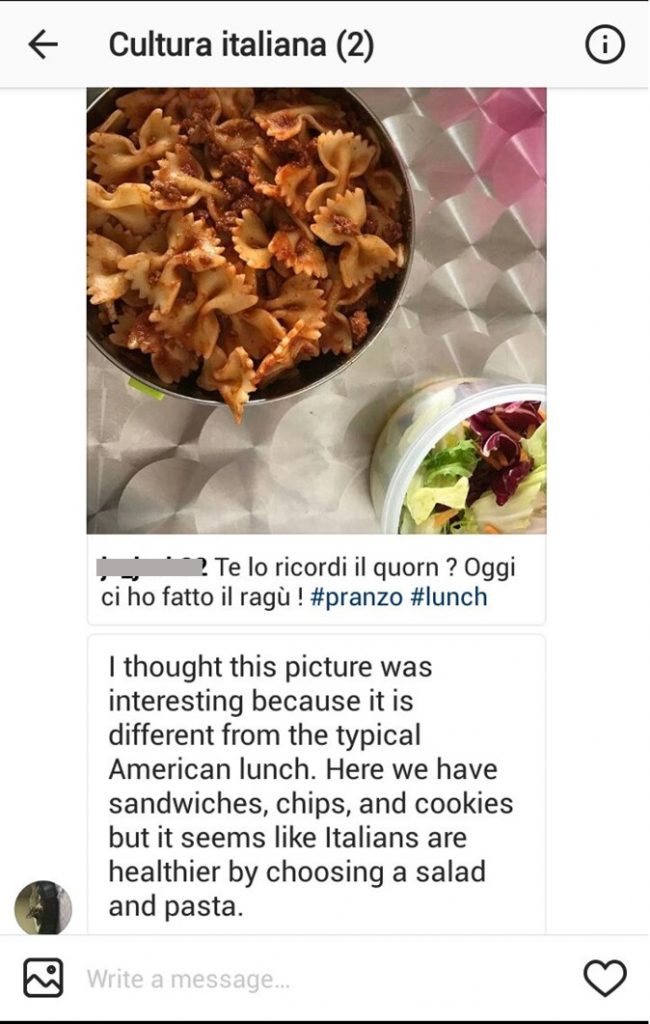Using Instagram to Foster Learners’ Autonomy for Intercultural Learning

Fabrizio Fornara, Ph.D. candidate in Instructional Systems and Learning Technologies; Italian and Spanish language instructor at the Florida State University; Center for the Advancement of Teaching.
Every day, hundreds of thousands of users worldwide publish snapshots of their daily life on social media. The posts they share are rich in current and authentic information that can be used in the foreign language classroom to promote cultural and intercultural learning. The vast majority of American students are already familiar with such social media tools as Facebook, Twitter, Instagram, and Snapchat. Educators can take advantage of these existing online practices to design activities that allow students to engage with the target language and culture in a personally relevant way. As Barbara Lafford (2009) points out, the “easy access to authentic target language materials in familiar formats has the potential to enhance student engagement with the target culture in ways that were not possible with the use of pre-Internet tools” (p. 690). Following her suggestion, I propose using Instagram to encourage students to engage with the target culture beyond the classroom. The richness and variety of cultural content available on Instagram, along with its worldwide popularity, makes it a valuable tool to build students’ interest in the target culture and to foster their autonomy for cultural and intercultural explorations. As using social media is primarily a personal act, students may develop a degree of agency and choice that is similar to the one they have when they use these tools for personal purposes.
The ACTFL World-Readiness Standards for Learning Languages define culture as a set of tangible and intangible products, behavioral practices, and philosophical perspectives of a society – in the words of Pamela Wesely (2012), what people have, what they do, and what they think or are. A well-designed activity gives students the opportunity to use Instagram to explore products and practices of the target culture and to reflect on the philosophical perspective from which they derive – i.e., the beliefs and values of a society. The goal of the activity, however, is broader than simple cultural learning; its aim is to develop students’ global awareness through intercultural reflections. For this activity, students use Instagram to follow a set of foreign users and to explore a set of hashtags related to selected themes of the contemporary foreign culture. Students also participate in an Instagram group chat and complete a set of assignments aimed at fostering their autonomy for cultural and intercultural learning.
Getting Started
While the activity per se is not very time consuming, it takes some time to prepare it. For each theme selected – 12 in my case, but you can easily extend or shorten the list –, I usually provide five or six hashtags to explore (click here for a complete list of hashtags that I used with my Italian language students last semester). Finding good hashtags requires some time, as they must meet the following criteria: They should aggregate posts shared mostly by native speakers, they should present relevant content – not just selfies –, and the content should be suitable for an academic context. Selecting foreign users to follow is also time consuming. The necessary condition is that the users are native speakers who live in the target country and post frequently about their everyday life – not just about one perfect, unique moment. I usually select accounts of ordinary people who have a fair number of followers but are not Instagram celebrities, so to avoid advertising and a distorted representation of the reality.
Instagram is a native mobile app; it also has a browser version but some features are only available through the app (i.e., creating a post, sending private and group messages, exploring Instagram Stories). Thus, it is important that, before introducing the activity, you make sure that your students have access to a smartphone. Students who do not have a smartphone can still use a computer or a tablet to create an Instagram account and to browse posts and hashtags but they will not be able to participate in the Instagram group chat. In this case, you may want to provide your students with an alternative platform to post their messages. One semester, I used GroupMe, which has a full browser version, and it worked just as well. Even if students already have an Instagram account, invite them to create a new one. Besides keeping their privacy safe, they will be able to see all the posts of the foreign users at once and not mixed with the posts of the other users they are following. On Instagram, it is easy to switch between multiple accounts – refer your students to the Instagram website to learn how to do it.
Once students have created an account, ask them to share their username with you so you can add them to the class group chat. Because the maximum number of members in an Instagram chat room is 15, you may need to create more than one group. Also, make sure that your students follow all the foreign users you selected. The easiest way to do so is to ask them to access your Instagram profile and follow all the users in your Following list. For this activity, students are not required to follow you and their classmates.
Before the activity starts, introduce in class the concept of culture as defined by ACTFL and show examples of cultural products and practices taken from Instagram. Also, train your students to analyze both the visual and textual elements of a post and guide them through the analysis of several posts before trying to infer a perspective. Finally, show your students how to share a post to the Instagram group chat and how to best participate in the group chat.
The Activity
The activity is designed for students who have already reached a novice level of proficiency in their speaking, writing, listening, and reading skills in the foreign language but only have a superficial awareness and understanding of the foreign culture. Thus, the activity is best suited for third-level language courses that do not have a strong cultural component but mainly focus on the study of the language. As the activity requires students to be in contact with the target culture (almost) daily – and in order to keep students’ interest and motivation high –, I usually run the activity only for four weeks. Every week, students explore three different themes – a new theme every other day –, usually exploring three hashtags per day.
These are the themes that we cover:
Week 1: The way people look and dress; common patterns of interaction and displays of affection; eating and drinking habits.
Week 2: Popular sports and social practices associated with sports; common recreational activities; common forms of entertainment.
Week 3: Common practices associated with work and the workplace; common practices associated with school and education; the layout of cities and towns.
Week 4: Products and practices that reveal a stereotyped or exaggerated view of a culture; how people relate to a different culture; how people use social media.
Each portion of the activity has a different focus. First, students use Instagram to explore and discuss products and practices of the target culture (Figure 1). Then, they complete a weekly worksheet comparing products and practices of the target culture with their own and reflecting on the philosophical perspectives of the target culture. At the end of the four weeks, students write a short essay comparing the philosophical perspectives of the target culture with their own.

Every morning from Monday to Saturday, I post on the group chat a message that contains information on the theme of the day and the hashtags to explore (“Today we focus on common recreational activities. The hashtags to explore are…”) (Figure 2). Students can access the hashtags by simply clicking on them; if they want, they can also explore other hashtags and browse the posts and stories of the users they follow. On Sunday, there is no specific theme to explore.

On at least four different days of the week, every student shares on the group chat a post that particularly struck his or her attention, adding a thoughtful comment (“Judging by all the pictures within the hashtag, a typical Italian breakfast seems to consist of a coffee and a pastry or croissant”) or a question (“Is it common to spend time with coworkers outside of work?”) (Figure 3). Alternatively, students can post a comment or ask a question about the Instagram stories they browsed. The posts students share should be on the theme of the day. This way, students can integrate their observations with the information shared by other students and build their messages on the previous messages. The instructor also participates in the chat by replying to students, by integrating the information they share, and by clarifying any doubt they may have.

At the end of each week, students complete an online assignment documenting their cultural and intercultural observations for the week – I usually put the deadline for the end of the following Tuesday. The assignment has two sections. In the first section, students list, for each theme covered during the week, the similarities and differences between the target culture and their own culture. In the second section, for each theme explored, students reply to a question that encourages their reflections on the beliefs and values of the target culture. At the end of the four weeks, students write a short essay reflecting on how the beliefs and values of the target culture relate to their own. Students receive a comprehensive weekly grade on a 10-point grading scale for participating in the group chat (one point per each day they post, up to four points) and for completing the online assignment (six points). Each weekly grade counts a 2% of the final grade of the course and so does the final essay, for a total of 10%.
I conducted the activity several times with my higher education students of Italian. Usually, they like the opportunity to use a familiar tool to engage with the Italian culture beyond the classroom (“I was already using my time to be on Instagram so it was cool to learn something in the process”). However, despite having the information right at their fingertips, most students were not following any Italian users on Instagram nor they were usually browsing Italian hashtags (“It was something I would’ve never done on my own”). But once the activity gets them started, they feel empowered to explore the target culture by themselves and to learn from the great variety of cultural information available online – and they have fun in the process (“I felt like I learned a lot more Italian culture through this activity than I ever did”; “The activity felt more fun than actual school work”).
Students usually use the class group chat to share their cultural observations and to read and engage with the information shared by their classmates (“This picture stood out to me. It seems like in Italy men are very affectionate towards each other with kisses and hugs”; “I agree! I think Italians are definitely more physically affectionate than Americans. A lot of their photos picture people hugging, kissing, or close together”). These observations encourage students to reflect on the similarities and differences between the target culture and their own culture (“Italians are more physically affectionate with their friends than Americans are”) and on the beliefs and values of the Italian culture (“Italians are profuse with expressing affection and have no concern in displaying physical affections”). Finally, students use the final essay to compare beliefs and values across cultures (“Italians seem to post more pictures of experiences or relationships, showing the emphasis they place on the other people in their lives. Americans, instead, seem to value their alone time more than Italians do and their posts reflect that”).
Adapting the Activity
I designed the activity with a typical face-to-face, college-level language course in mind. However, you can easily modify the activity to adapt it to your modality and setting and to best accommodate your instructional needs. For example, you can select only the themes that match your syllabus and extend the time dedicated to each theme presenting only one hashtag per day. Or you can focus less on the hashtags and more on the users, selecting more accounts to follow – I usually select around 50 – and focusing mainly on their posts and stories. Or you can focus on regional differences within the target culture and provide different set of users and hashtags from specific areas of the country.
The activity can be adapted to virtually any language and culture, although for some languages the preparation phase may be a little more complicated than for others. In my case, it was relatively easy to identify good Italian hashtags. However, it may be harder for instructors of languages associated with more than one national culture (i.e., Spanish, French) and for instructors of world languages (i.e., English). One possible solution is to look for hashtags that include words and expressions used exclusively within the target culture. For example, instead of using the well-known word #amore (love) to show common displays of affection in the Italian culture, I use expressions that only people who live in Italy commonly use, such as #semplicementenoi (just us) and #ilmiosorriso (my smile). If finding good hashtags proves too complicated for your target culture, just focus on the users; students can explore your selected themes through their posts and stories.
To Conclude
Foreign language educators can take advantage of the affordability and widespread diffusion of personal computers and mobile devices to design activities that require students to explore current and living representations of the target culture online. Particularly, they can take advantage of the content shared by worldwide social media users to provide students with a regular exposure to cultural information that is authentic, current, and timely. A well-designed activity on Instagram motivates students to take responsibility for their own cultural and intercultural learning and empowers them to become autonomous, lifelong learners. By motivating students to develop an understanding of diverse cultural perspectives, we are helping them to become informed global citizens who are ready to navigate a culturally diverse world.
References
Lafford, Barbara. “Toward an ecological CALL: Update to Garrett (1991)”. The Modern Language Journal 93, no. s1 (2017): 673-696.
Wesely, Pamela. “Cross-cultural understanding in immersion students: A mixed methods study”. L2 Journal 4, no. 2 (2012): 189-213.
Biographical Note
Fabrizio Fornara is a Ph.D. candidate in Instructional Systems and Learning Technologies and an Italian and Spanish language instructor at the Florida State University, where he also works for the Center for the Advancement of Teaching. His research focuses on social media in foreign language education and intercultural language learning. Email: ffornara@fsu.edu


This is absolutely amazing and extremely well laid-out (the article as well as the activity itself). I will definitely be piloting something similar this summer and fall.